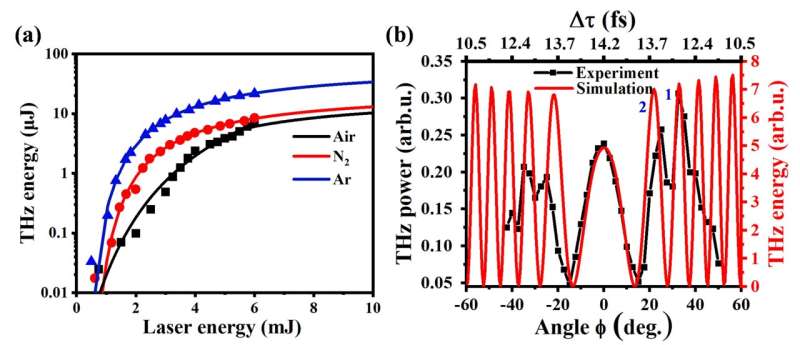Sapphire femtosecond laser filamentation in argon at 1 kHz repetition rate

A new publication from Opto-Electronic Advances considers an over 20 μJ THz laser pulse generated at 1 kHz in gas media.
Terahertz (THz) science and technology has received extensive attention from scientific researchers from all around the world over the past 20 years because of its prospective application potential in security imaging, medical diagnosis, military, wireless communications and astronomy. However, the development of high-power broadband THz radiation source has been a challenging task in the above-mentioned fields.
Among various THz radiation sources, THz radiation source based on femtosecond laser filament has the advantages of broadband (~200 THz), high amplitude (100 MV/cm) and no limitation of damage threshold. In addition, the THz generation method based on the femtosecond laser filamentation confines the THz wave inside the filament, which can eliminate the diffraction and absorption during the propagation of the THz wave in the atmosphere and make the remote delivery of the THz wave become possible.
The THz generation scheme based on the dual-color femtosecond laser filamentation has higher energy conversion efficiency than that using single-color femtosecond laser. In this scheme, the intensity, bandwidth, polarization and other characteristics of the THz radiation can be affected by many laser parameters including the temporal delay, dispersion, polarization, wavelength, spatial departure of the dual-color fields. Even the ambient gas species play a crucial role too. In order to develop an efficient THz radiation source, all these parameters need to be carefully designed and manipulated.
The research group led by Prof. Weiwei Liu from Nankai university used femtosecond laser with single pulse energy of 6 mJ to generate the dual-color laser filamentation by frequency doubling the fundamental laser via a β-BBO crystal. The dual-color laser beams achieve the perfect spatial-temporal overlap through a tilted α-BBO crystal. Meanwhile, a dual-wavelength plate was used to make the dual-color laser beams have the identical polarization. The energy of the THz pulse generated from the laser filament in argon can be up to 21 μJ and the corresponding THz conversion efficiency reaches 0.35%.
In this work, the ambient gas species' influence on the THz generation efficiency by the dual-color laser filamentation was investigated experimentally. The experimental results show that the highest conversion efficiency of THz radiation is achieved in argon gas. The relationship between the tilting angle of α-BBO and the generated THz power in argon was also investigated. α-BBO with optimal tilting angle and pre-designed thickness can simultaneously compensate the time delay and spatial walk-off of the two-color laser beams, playing the critical role in improving the generation efficiency of THz wave. This research work achieved a breakthrough in the energy conversion efficiency of THz wave generated by the two-color femtosecond laser filamentation, which is of great significance for the study of high-intensity THz sources and the exploration of the interaction between strong THz beam and materials.
More information: Zhiqiang Yu et al, 0.35% THz pulse conversion efficiency achieved by Ti:sapphire femtosecond laser filamentation in argon at 1 kHz repetition rate, Opto-Electronic Advances (2022). DOI: 10.29026/oea.2022.210065
Provided by Compuscript Ltd





















